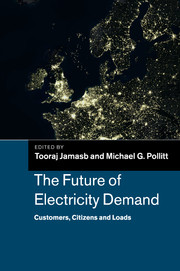Book contents
- Frontmatter
- Contents
- List of Figures
- List of Tables
- List of Boxes
- List of Contributors
- Foreword
- Preface
- Acknowledgements
- Introduction and overview of the chapters
- Part I The economics
- Part II Technology
- Part III Social dimensions
- Part IV Policy and regulation
- 14 Demand-side management strategies and the residential sector: lessons from the international experience
- 15 Electricity distribution networks: investment and regulation, and uncertain demand
- 16 The potential impact of policy and legislation on the energy demands of UK buildings and implications for the electrical network
- 17 The ADDRESS European Project: a large-scale R&D initiative for the development of active demand
- 18 Daylight saving, electricity demand and emissions: the British case
- 19 Concluding reflections on future active networks and the demand-side for electricity
- Index
- References
17 - The ADDRESS European Project: a large-scale R&D initiative for the development of active demand
from Part IV - Policy and regulation
Published online by Cambridge University Press: 05 March 2014
- Frontmatter
- Contents
- List of Figures
- List of Tables
- List of Boxes
- List of Contributors
- Foreword
- Preface
- Acknowledgements
- Introduction and overview of the chapters
- Part I The economics
- Part II Technology
- Part III Social dimensions
- Part IV Policy and regulation
- 14 Demand-side management strategies and the residential sector: lessons from the international experience
- 15 Electricity distribution networks: investment and regulation, and uncertain demand
- 16 The potential impact of policy and legislation on the energy demands of UK buildings and implications for the electrical network
- 17 The ADDRESS European Project: a large-scale R&D initiative for the development of active demand
- 18 Daylight saving, electricity demand and emissions: the British case
- 19 Concluding reflections on future active networks and the demand-side for electricity
- Index
- References
Summary
Introduction
In less than twenty years, we have seen tremendous changes in the demand mix worldwide spurred primarily by the dawn of the digital age with its ever more energy-hungry computers, server farms, telecommunication equipment, etc. The expected evolution in the electricity demand for the next 10–20 years is even more radical. While efficiencies in current electricity-using devices are expected to improve (e.g. lighting being the most prominent example), electricity demand has the potential to increase significantly because of the electrification of road transportation, combined with the demise of fossil fuels for space heating and the ever growing need for space cooling. Electricity is the energy carrier par excellence in a low-carbon world; therefore, demand for it will increase, if not significantly in the UK (see Ault et al., this volume), then certainly globally.
Electric power systems have been designed and built to allow for the supply side to follow demand quite well (aside from the rare blackout in most advanced countries). Currently, most low-carbon generation technologies (like wind power and even nuclear power stations) are not well suited to follow the constant fluctuations of demand. Hence, in a power system dominated by generally uncontrollable low-carbon generation, keeping the same operating paradigm may be increasingly unreliable and overly costly.
- Type
- Chapter
- Information
- The Future of Electricity DemandCustomers, Citizens and Loads, pp. 423 - 444Publisher: Cambridge University PressPrint publication year: 2011
References
- 1
- Cited by



